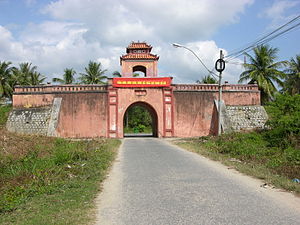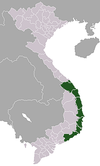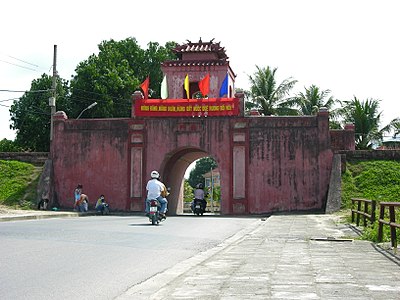Diên Khánh district
- View a machine-translated version of the Vietnamese article.
- Machine translation, like DeepL or Google Translate, is a useful starting point for translations, but translators must revise errors as necessary and confirm that the translation is accurate, rather than simply copy-pasting machine-translated text into the English Wikipedia.
- Consider adding a topic to this template: there are already 952 articles in the main category, and specifying
|topic=will aid in categorization. - Do not translate text that appears unreliable or low-quality. If possible, verify the text with references provided in the foreign-language article.
- You must provide copyright attribution in the edit summary accompanying your translation by providing an interlanguage link to the source of your translation. A model attribution edit summary is
Content in this edit is translated from the existing Vietnamese Wikipedia article at [[:vi:Diên Khánh]]; see its history for attribution. - You may also add the template
{{Translated|vi|Diên Khánh}}to the talk page. - For more guidance, see Wikipedia:Translation.
Diên Khánh district Huyện Diên Khánh | |
|---|---|
 Front gate of the old citadel of Diên Khánh | |
 | |
| Country |  Vietnam Vietnam |
| Region | South Central Coast |
| Province | Khánh Hòa |
| Capital | Diên Khánh |
| Area | |
| • Total | 198 sq mi (513 km2) |
| Population (2003) | |
| • Total | 134,118 |
| Time zone | UTC+7 (Indochina Time) |
Diên Khánh is a rural district (huyện) of Khánh Hòa province in the South Central Coast region of Vietnam. Diên Khánh is one of the oldest citadels in the south of Vietnam and it is one of the precious vestiges for studying ancient citadels. As of 2003 the district had a population of 134,118.[1] The district covers an area of 513 km². The district capital lies at Diên Khánh.[1]
Diên Khánh Citadel

The Diên Khánh Citadel is situated in Diên Khánh Townlet. The Citadel was built by French officer Olivier de Puymanel for Nguyễn Ánh in 1793 with an area of 36,000 square meters according to the Vauban military architecture which was popular in Western Europe in 17th - 18th centuries.[2]
The citadel's wall was in an inequilateral hexagon with a height of 3.5m. The outer face was vertically constructed while the inner was a little bit sloping by two terraces forming a favorable pavement. Inside the corners, there were large fields which were convenient for military residents. On the top of the corners there stood fortresses 2m high with canons above. On the roof of the citadel, there were closet bamboo and other barricade trees. Surrounding the citadel were moats of 4 to 5 meters deep, 10 meters wide, flooded by water.
At first the citadel had 6 gates but now only 4 remain which are the East Gate, West Gate, Front Gate (to the south) and Back Gate (to the north). There was also a royal palace, private residents of feudal mandarins, warehouses and jails.


Gallery
-
 1 resort in Diên Khánh
1 resort in Diên Khánh -
 Double oil tree (left) and Trịnh Phong shrine
Double oil tree (left) and Trịnh Phong shrine - Eastern city gate of Diên Khánh town
- Cổng Tây thành cổ Diên Khánh
References
- ^ a b "Districts of Vietnam". Statoids. Retrieved March 20, 2009.
- ^ Oscar Chapuis A History of Vietnam: From Hong Bang to Tu Duc 1995 - Page 141 "In 1793, he succeeded in capturing Qui Nhon, after having secured Dien Khanh, Binh Khang, Phu Yen, and Binh Thuan. Nguyen Nhac had to call on Phu Xuan for help. King Canh Thinh, Nguyen Hue's son, dispatched 17,000 men under ."
12°15′17″N 109°5′37″E / 12.25472°N 109.09361°E / 12.25472; 109.09361
- v
- t
- e














